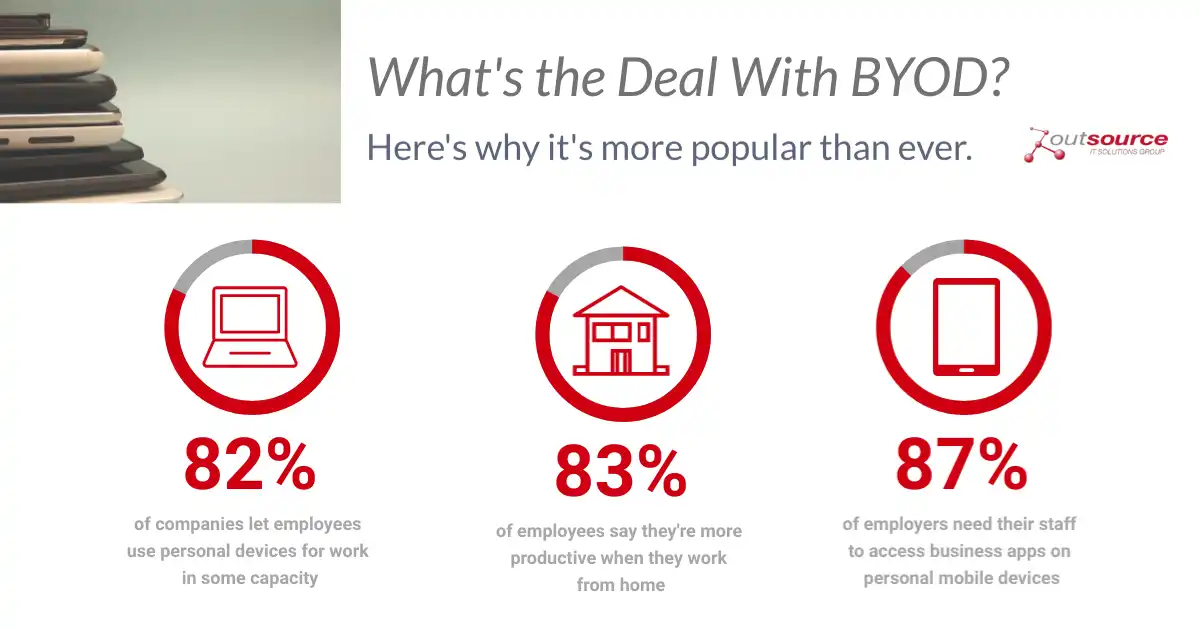The 2021 US census found that roughly 9 million Americans work remotely. Although many companies originally planned a return to the office, fewer are actually doing it. This is unsurprising, 83% of employees prefer remote work. However, this leaves many discussing the risks of BYOD policies.
“Bring Your Own Device” (BYOD) and remote work often go hand-in-hand. It’s generally much more cost-effective to let employees use devices at home than it is to ship company-issued ones. Even among in-office employees, many are allowed to bring personal devices to work.
The problem is that BYOD opens up a whole new list of security issues. This doesn’t mean you should abandon your BYOD policies. It means that it’s important to understand BYOD’s risks and issues so you can mitigate them.
What Are BYOD Devices?
In simple terms, a BYOD device is an employee’s device. If it wasn’t company-issued, it’s BYOD. This includes laptops, desktops, smartphones, and any other electronic device an employee may use to work.
It also includes personal devices that connect to your network. For example, if an employee connects their personal smartphone to your office Wi-Fi, it may still qualify even if they aren’t working on it. That’s because the connection still has cybersecurity implications.

Sources:
https://techjury.net/blog/byod-stats/#gref
https://www.digitalguardian.com/blog/ultimate-guide-byod-security-overcoming-challenges-creating-effective-policies-and-mitigating
Bring Your Own Device to Work Security Issues & Solutions
1. Lost or Stolen Devices
An employee’s device is doing much more than work. 79% of American adults have their smartphone with them for 22 of the 24 hours each day. That means they’re regularly taking their devices to public locations where loss or theft is a risk.
Enforce a strong password policy on any device that accesses corporate information. This reduces the chance of an unauthorized person accessing data on a lost or stolen device. Biometric validation (e.g. face or fingerprint scans) can decrease this risk even further.
2. Mobile Security
The majority of people with malware on their mobile device don’t realize it’s there. Hackers usually use cell phones more as a “taxi” to networks with sensitive data than as a primary target. Malware is often unintentionally downloaded from app stores or personal email accounts.
Educate your staff about mobile cybersecurity risks. Most people are interested in protecting their personal devices too. Therefore, this training is good for you and for them. You may also have more “hard” rules in place, such as no working on public Wi-Fi.
3. No Option to Remotely Wipe Devices
It’s not fair to remotely wipe someone’s personal device. Yet, remote wiping is an important cybersecurity measure for most companies. It prevents data leakage when theft or loss occurs or when an employee leaves the company.
Lean on cloud-based data to reduce the amount of information employees must download. You may also block download capabilities for certain files to keep them off BYOD devices. You don’t need to remotely wipe anything if it wasn’t there to begin with.
Reduce The Security Risks of BYOD With a Managed Cybersecurity Provider
4. Corporate Data on Personal Devices
Mixing work and personal activity on one device can have unintended consequences. Human error can cause an employee to leak company data in personal interactions or reveal private interactions to co-workers.
Make sure you use separate accounts for work. Letting employees use their personal email address or social media accounts for company activities is strongly discouraged. Malware spread and data leakage is far too easy when you combine the two.
5. Compliance Risks
Regulatory compliance measures have a checklist you need to follow to meet their standards. Not every personal device will qualify (in fact, most won’t). Still, BYOD policies are not an exemption to regulatory standards.
The best way to mitigate this issue may vary based on your industry’s compliance standards. Take the time to review them and implement policies as needed. In some cases, you may need to scale back BYOD if your regulatory body requires it.
6. Unsupported or Outdated Software
Various devices will inevitably come with various operating systems. This leads to the risk that some employees may not be able to run business applications. Outdated software is also more prone to data breaches because developers have not yet patched known vulnerabilities.
As remote work is normalized, many companies have bandwidth requirements for their employees. Consider similar policies with operating systems. If an employee can’t securely use business applications on their device, they can’t use that device.
Remember to include mobile phones in these policies, not just computers.
Learn More About The Security Measures You Should Take |
Reduce Potential Problems With BYOD With Help From An IT Partner
Balancing employee satisfaction and security requirements can be difficult when it comes to BYOD. Prohibiting BYOD is not the answer. Most employees do prefer to separate their personal and work devices, but shipping company-issued devices to remote workers adds up.
Keep personal activity off your corporate network with solid cybersecurity protocols. Outsource Solutions Group specializes in managing IT for hybrid work environments. We’ve worked with varying BYOD policies and can offer advice and services to mitigate security risks.
Reach out to us to get a quote for the device security management services you need.

